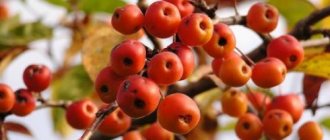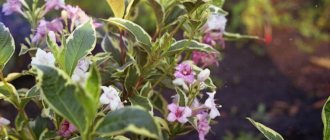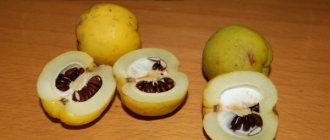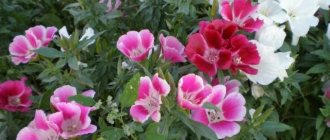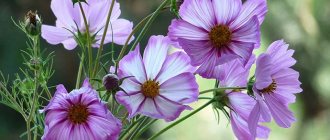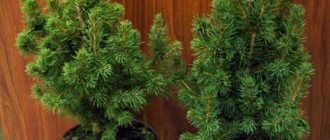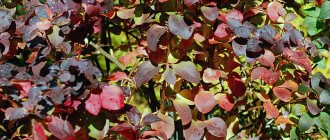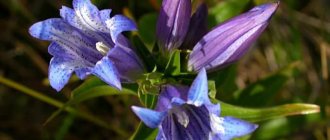Variety of types and varieties of rowan
Depending on the crop variety, the size of the trees may vary: the height of the reduced rowan is no more than 60 cm, and the size of the Tibetan rowan often exceeds 20 m. Low-growing varieties of rowan are actively used for decorating small garden plots.
In autumn, rowan foliage changes color, and the clusters become rich red, orange, yellow, pink or white. The average diameter of the fruit is 1 cm, which is why they are often called berries, but in fact they are miniature apples. Their bright color attracts many birds to the garden, and the white and yellow fruits, due to their unattractiveness to birds, remain on the branches during the winter. Rowan foliage can have either a complex (pinnate) or simple shape with a single leaf blade and one petiole. The leaf plate is pinnate in shape - with jagged edges, has a length of 10 to 30 cm. The tree also has small white or cream (sometimes with a pinkish tint) flowers that form paniculate or corymbose inflorescences from 5 to 20 cm in diameter. They bloom in spring or early summer. Young trees have smooth bark, which gradually begins to crack with age.
Today, many varieties of rowan have been discovered, which are actively used for landscape purposes. Each type has its own unique appearance, as well as decorative qualities and features.
Mountain ash
This variety is the best option for central Russia. The plant can often be found in the wild in Europe, Siberia, the Far East, and North Africa.
In maturity, the tree can reach up to 15 m in height, and is often found in the form of a large shrub. This plant has large, delicately shaped, odd-pinnate dark green leaves, which in autumn change color to yellow, orange and red.
The flowering time of the common rowan is the end of July, with a period of about 7 – 14 days. Small beige flowers sprout on the tree, forming large corymbose inflorescences. They are characterized by a strong specific aroma, reminiscent of fish.
This variety of rowan is characterized by red, sweet berries that begin to ripen in late summer and remain on the tree until frost begins.
The mountain ash is characterized by its low maintenance requirements. Its propagation is carried out by seed, and sometimes the cutting method is also used. Today, many decorative forms of this species have been discovered, each of which differs in the shape of the crown (spreading, weeping or pyramidal), the color and taste of the fruit, as well as the foliage color (white-variegated, golden, etc.). Trees of this variety are often used for planting in garden plots and park areas: both for complex compositions and as single specimens.
Rowan nevezhinskaya
A distinctive feature of Nevezhin rowan is its fruits without characteristic bitterness. The village of Nevezhino, in the Vladimir region, is considered the birthplace of this species. A few centuries ago, this variety was actively cultivated throughout Central Russia, and over time, breeders managed to develop a separate group of decorative tree forms. Later they were crossed with other types of mountain ash, as well as with pears, medlar and hawthorn.

Nevezhinsky rowan reaches from 10 to 15 m in height at maturity and has a dense, wide-pyramidal crown. This is a tree with smooth bark of a soft brown or reddish-burgundy hue and solid rounded-elliptical leaves with jagged edges. Young leaves have a white felt color, which turns green over time. In mid-autumn, the foliage turns scarlet and brown. The flowering period of the tree begins in June and lasts approximately 7–10 days. Small white flowers are collected in large corymbose inflorescences. Edible, round-shaped fruits of the tree with a diameter of up to 2 cm have a rich fiery color, they ripen in September. The fruits of the variety are very juicy, without a tart aftertaste, with a high content of biologically active substances, and their vitamin C content exceeds its concentration in lemon. Nevezhinskaya rowan has a high level of frost resistance and tolerates air pollution well. It grows and develops best in alkaline soil. Reproduction occurs by seeds; the plant rarely lends itself to cuttings. This species has several garden ornamental varieties, which are characterized by large inflorescences and golden foliage. The best pollinator for such rowan is the Businka variety.
Homemade rowan
Rowan, or large-fruited (Crimean), grows throughout Europe (with the exception of its northern parts), Crimea, northwestern Africa and southwestern Asia.
In adulthood, the crop can reach from 15 to 30 cm in height, and has a wide pyramidal or spherical crown shape. This is a type of rowan with large (up to 20 cm in length) odd-pinnate leaves, similar in appearance to the foliage of the common rowan. Flowering time occurs in the first half of June and lasts, on average, 1.5 - 2 weeks. Large, wide-pyramidal inflorescences are formed by small white or pinkish flowers up to 2 cm in diameter. This species is also characterized by a high level of winter hardiness and drought resistance, and is practically not attacked by pests. The plant is propagated by seeds. In gardens, this species is actively used to create decorative alleys, and also as a fruit tree. Fully ripened fruits have a sweet taste and are used for both culinary and medicinal purposes.

Rowan intermediate (Swedish)
These are trees with an oval crown, reaching 10 - 20 m in height, the growing area of which is Northern Europe. The species is characterized by smooth gray bark and entire oblong-ovate leaves that are slightly divided into lobes. In autumn, the plant's foliage takes on rich scarlet and orange tones. The flowering period of the tree is from the beginning of summer, for 7 – 14 days. Large corymbose inflorescences contain small white flowers. The bright red, edible fruits, 1 cm in diameter, often ripen in mid-August. This species is practically not amenable to cuttings; plants are propagated by seed or grafting. They adapt well to drought, severe frosts and air pollution.

Rowan hybrid
The variety is widespread in Scandinavia and is a natural hybrid of intermediate and common rowan. An adult tree reaches up to 10 - 15 m in height, young seedlings have a columnar or conical crown, which in adulthood takes on a rounded shape. Whole lobed leaves take on a rusty-brown hue in autumn. Flowering begins in late May - early June and lasts about two weeks. Large white flowers, up to 2 cm in diameter, form corymbose inflorescences. This type of rowan has many edible varieties with juicy bright red fruits up to 1 cm in diameter, which ripen in September. The crop is best propagated by seed and cuttings.

Is there white rowan
Rowan with white berries is a plant that is not often found in Russia, but it is not a legend. It exists in the wild, hiding under the canopy of mountain pine forests, for example, the Kene rowan, discovered by scientists in the warm climate of Central China, or the Kashmir rowan, common in the Western Himalayas. There are also white-fruited varieties that arose as a result of the focused work of breeders. By crossing an ordinary rowan with a bicolor one, they got a new hybrid - Arnold's rowan, which has many interesting variations with fruits of different colors. Among them is the decorative variety White Swan, whose large berries resemble snow in color.
Varieties of common rowan
The common rowan is the most popular species of this plant, with many ornamental varieties ranging in color from orange to bright red.
Scarlet large
Large Scarlet rowan is one of the most valuable varieties of ordinary rowan; it belongs to the medium-late ripening period. During the hybridization process, experts used a mixture of pollen from several pear species. This is a tree of medium height (up to 6 m) with a pyramidal crown of medium density and juicy fruits weighing more than 4 g, which externally resemble cherry berries and are almost not bitter. Cylindrical, slightly flattened mini-apples of regular shape have an average weight of 1.7 g and a slightly ribbed scarlet-red surface. They are characterized by a sweet and sour taste and a spicy rowan aftertaste. The variety is characterized by a particularly high level of winter hardiness and can adapt to frosts down to -50 °C. The plant is classified as a fast-growing universal variety. The average yield of one mature tree is more than 150 kg.
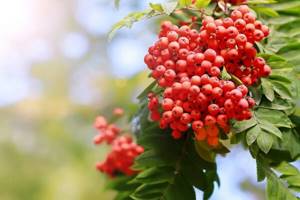
Bead
Rowan Businka is a low-growing variety, its height at maturity does not exceed 3 m. This is a tree with an average level of density of a rounded crown and red-ruby round fruits, the taste of which is very similar to the taste of cranberries. These are fruits with juicy, creamy pulp of medium density and a sweet and sour taste without bitterness or astringency. The “Businka” variety begins to bear fruit 4-5 years after planting. It is characterized by sun-loving, high levels of frost resistance and disease resistance. The variety's yield level is stable and has good transportability.

Grenade
The Rowan pomegranate variety is a hybrid of the common rowan and large-fruited hawthorn. A mature plant reaches up to 3–4 m in height and has fruits the size of cherries. The fruits have a sweet-sour, slightly tart taste, with virtually no bitterness. The variety is also characterized by a high level of winter hardiness and productivity; it begins to bear fruit 3 years after planting.

Gorgeous
The Beauty variety is a hybrid of rowan and pear. This is a tree with a wide pyramidal crown, reaching more than 6 m in height at maturity. The variety is characterized by abundant annual yield. Slightly tart large fruits of the tree weighing up to 2 g have a rich orange-red color and an uncharacteristic oblong shape.
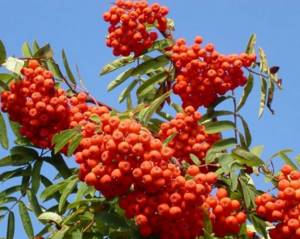
Hope
The tree of the Nadezhda variety is low, with large (1.8 - 2 g) fruits, which contain a variety of substances valuable for the body. This is one of the fastest growing and most productive varieties.
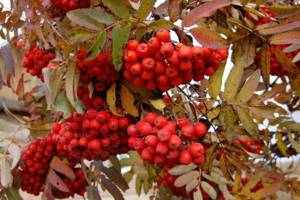
Ruby
The Rubinovaya variety is a dwarf plant (2 - 2.3 m in height) with a spreading crown shape and large fruits (1.8 g) ruby colored with a characteristic sweet and sour taste.

Titanium
The Titan variety is the result of crossing rowan, pear and red-leaved apple. A tree of medium height with a wide rounded crown has large (up to 2 g) fruits of a dark scarlet color with a bluish coating on the surface. This is one of the most winter-hardy varieties with abundant annual yields.
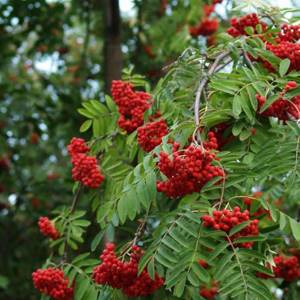
More about the species characteristics of rowan - in the video:
Varieties of sweet-fruited rowan
The discoverer of sweet rowan varieties was the famous Russian breeder I.V. Michurin: thanks to his work, varieties such as Burka, Granatnaya, Dessertnaya, and Lickernaya appeared. The modern list of this species is unusually wide.
Burka
The Burka variety is one of the garden forms of rowan, the result of crossing alpine sorbaronia and ordinary rowan. Fruiting of the plant begins in the 2nd – 3rd year of growth. This is a low tree with a compact crown, reaching no more than 2.5 m in height at maturity. The variety is characterized by simple pinnate leaves, as well as a high level of frost resistance. Rowan Burka gives a rich yield (more than 50 kg per tree). The medium-sized brown fruits have a slightly tart taste and can be stored for 3 to 4 months.
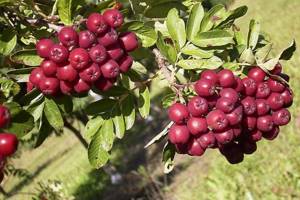
Wefed
Rowan Vefed is similar to the Nevezhin rowan. This medium-ripening variety is characterized by a sparse, rounded crown. In adulthood, the plant can reach up to 4 m in height. This is a small tree with a stable level of fruiting and orange-pinkish shiny fruits, the weight of which is more than 1.5 g. They have yellow, tender, sweet and sour pulp, therefore they are completely suitable for fresh consumption.
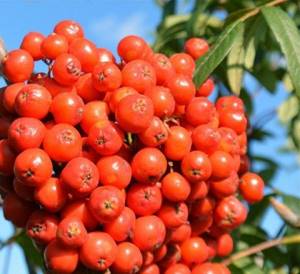
The variety also has a high level of frost resistance, disease resistance and abundant fruiting, which begins in the 3rd – 4th year of growth. The ripening period for the harvest occurs in the second half of August.
Sorbinka
Rowan Sorbinka is classified as a mid-autumn ripening plant. The tree of this variety is small in size (at maturity it reaches up to 6 m in height) with an obovate crown of medium density. It begins to actively bear fruit in the 4th year of growth. The variety is characterized by red, round-shaped fruits, weighing more than 2.7 g, and yellowish, juicy, sweet and sour pulp without astringency or bitterness. The crop grows and develops best in sunny areas; it is winter-hardy and practically not susceptible to diseases.
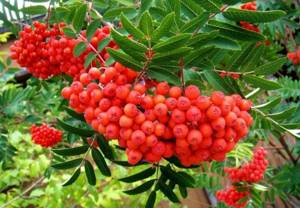
Dessert Michurina
This variety is also popularly called “miracle berry”. This small tree, reaching up to 2 m in height, is distinguished by active flowering in the spring. From July to August, large (1.5 - 2 g) edible fruits of a rich ruby color with a sweetish-tart flavor ripen on the tree. They are rich in organic acids and minerals, which is why they are often used both for making compotes and teas, and in folk medicine.
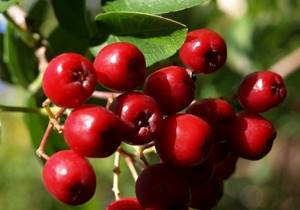
Liqueur Michurina
The Likernaya variety is the result of crossing the Burka variety with an apple tree and a pear tree. A tree with a sparse crown, reaching up to 5 m in height in adulthood, produces large fruits with a diameter of up to 15 mm with a dark, burgundy to black color and a bluish bloom, sweet and sour in taste, containing ascorbic acid in high concentrations. They are used to make desserts and also as a seasoning for soups and sauces. The variety is characterized by rich yield (up to 120 kg) and a high level of drought and winter hardiness. Rowan of this variety begins to actively bear fruit in the 5th year after planting; its flowering period is at the end of May - beginning of June. The fruits begin to ripen in the first half of autumn, usually in September.

Important! Despite a sufficient level of winter hardiness, the plant may be susceptible to rot.
Fresh fruits can be stored for up to a month. In order for the tree to bear fruit better, experts advise cross-pollination.
Daughter of the vat
This variety has an early autumn ripening period. A medium-sized tree with a sparse paniculate crown begins to bear fruit abundantly in the 5th year from the moment of planting. The variety is characterized by oblong-shaped fruits of a rich fiery color, weighing 2 g. Fruits with yellow flesh without a tart or bitter aftertaste. The variety Daughter Kubova has active fruiting, the yield of one tree, on average, is up to 90 kg. The ripening period of the fruits occurs in August, they are used both fresh and for seaming. The most optimal for the variety is loose soil; the tree also does not tolerate waterlogging.
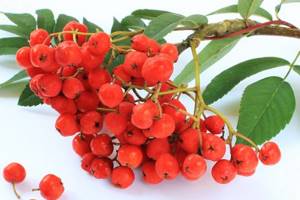
Sugar Petrova
Sweet-fruited mountain ash Sugar Petrova is considered one of the rarest plant varieties, which was almost lost, but breeders were able to restore and propagate the plant. Sugar Petrova is the sweetest variety of rowan; its fruits have a sugary taste. They are used to make wines, liqueurs, juices, compotes, jelly, and jams. Moreover, they contain vitamin C (the concentration of which is higher than in lemon), carotene (more than in carrots) and P-active substances (more than in apples). Rowan apples of this variety also contain sorbitol - a natural sugar substitute for people with diabetes and iron, which is 3 - 4 times more than in any fruits and berries.
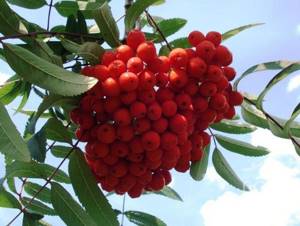
Solar
Solar ash belongs to the group of plants with early autumn ripening. It is a medium-sized tree with a paniculate crown, thick, greenish-gray shoots and compound, odd-pinnate, dark green leaves with a serrated, crenate edge. It begins to actively bear fruit in the 5th year of growth. The variety is distinguished by oblong, weighing up to 2 g, bright orange fruits with a cherry tint. They contain rich yellow flesh with a pleasant sweet taste without astringency or bitterness. Their ripening time begins in mid-August. Due to the rich content of vitamins and nutrients, rowan fruits are actively used in the field of traditional medicine for the treatment and prevention of diseases.
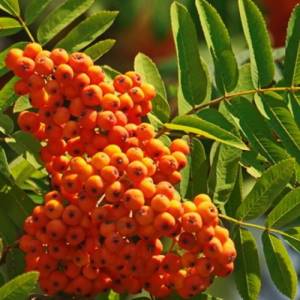
Moravian
Moravian mountain ash is a tall tree with a narrow pyramidal crown, which gradually becomes wide pyramidal with age. The leaves of the tree reach up to 25 cm in length; they differ slightly in shape from other varieties. One leaf contains from 7 to 9 pairs of smaller leaves, which extend from each other by 2 - 3 cm on a common petiole, which gives the crown an openwork appearance. The leaf blade has a lance-shaped shape and pronounced openwork edges. Moravian mountain ash begins to bloom 1 - 2 days later than other varieties; it is characterized by large inflorescences and oval-shaped fruits up to 1 cm in diameter with a scarlet-red color and pale orange juicy and sweet pulp without a tart aftertaste.
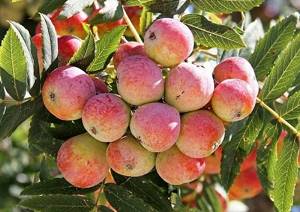
Is the mountain ash edible?
Rowan berries are relatively edible, since they are undesirable to eat raw (especially in large quantities), because they have a strong astringent, diuretic (up to kidney damage) and laxative effect due to the high level of parasorbic acid. By the way, it is this acid that gives the fruits a specific bitterness.
However, after cooking (heat treatment, drying) or freezing, the berries become sweeter. Therefore, it is better to collect them after the first frost (for a similar effect, the berries can also be placed in the freezer).
Rowan berries contain vitamins A (even more than carrots) and C (more than red currants), as well as other beneficial substances, such as pectin, malic acid and tannins. Traditionally, the berries were used to prevent scurvy and treat gout, colds, flu and rheumatism.
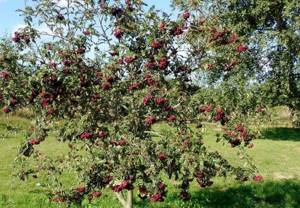
Sweet-fruited rowan.
Varieties of decorative rowan
Some varieties of rowan are most actively used for decorating gardens and summer cottages - due to their high decorative qualities. In addition to the usual scarlet and black mountain ash, breeders managed to develop unique varieties with fruits in yellow, orange and even white tones.
Yellow
This is a variety with odd-pinnate compound leaves, which consist of 10 - 15 narrow leaflets with serrations. In summer they have a dark green color, which changes to bright yellow and red shades in autumn. Thin flexible tree branches bend to the ground when there is a bountiful harvest. The small white flowers of yellow rowan form inflorescences 8–10 cm in diameter, and its fruits, collected in large clusters, are inedible for humans in their pure form, but very attractive to birds. They are also used to make rowan kvass, jam, or as an original filling for pies.

Ogonyok
This variety is an excellent solution for novice gardeners who want to harvest an early harvest with rich taste. A short tree, distinguished by its ease of care and abundant yield, produces fruits whose color changes with the stage of ripening: at the initial stage they have a light yellow tint, which over time changes to bright scarlet. The main advantage of this variety is its resistance to all kinds of unfavorable weather conditions: this rowan can easily tolerate both drought and severe frosts.

Kubovaya
The Kubovaya variety was bred using the selection method and is a derivative form of Nevezhin rowan. This tree of medium height and a sparse paniculate crown has large, thin leaves and short, pointed, lanceolate leaves. It is characterized by bright orange, without noticeable astringency and bitterness, oblong fruits with juicy, delicate-tasting bright yellow flesh. The ground rowan fruits of this variety are consumed fresh, and are also used for preparations for the winter (jams, preserves or marmalade). Their ripening period falls in the first half of September. The Kubovaya variety is used both when creating single plantings and in creating garden compositions.

Kene
Rowan Kene belongs to the dwarf varieties (up to 2 m in height) with edible, sour fruits that are devoid of bitterness and astringency. Its maximum yield is no more than 2 glasses. Despite this, this variety of rowan is highly valued in the field of garden design for its rich decorative qualities. The fruits of the tree begin to ripen in August, have a snow-white color, and their length is no more than 6 - 7 mm in diameter. Rowan Kene begins to actively bloom and bear fruit from 5 years after planting.
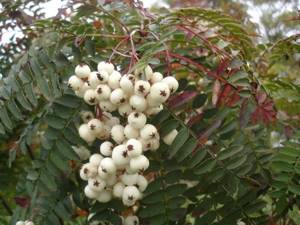
In garden design, the method of combining different varieties of rowan trees is actively used. So, when planting in one area, combining rowan varieties Yellow, Large Scarlet and Kene, you can get an excellent garden composition.
Planting white rowan
The rules for planting and caring for white rowan are in many ways similar to those developed for the most common varieties of rowan. This plant is unpretentious, but there are some requirements, compliance with which is highly desirable for the tree to grow healthy and beautiful.
Recommended timing
Young white rowan trees can be planted on the site in the fall (September-October) or early spring (preferably no later than April). If the seedling is prepared with a clod of earth, the season does not really matter. However, in the case of planting a plant with bare roots in the ground, it is best to do this in the fall, during the leafless period - then there is a greater chance that the white rowan will take root well.
Choosing a suitable location
The place in the garden most suitable for white rowan should have the following characteristics:
- sunny and dry, preferably at a slight elevation (best of all - in the upper third of the southern or western slope of the hill);
- protected from drafts and strong gusts of wind;
- well-drained soil that does not allow dampness and stagnation of water.
White rowan is not particularly demanding on the composition of the soil. However, on fertile soil, ideally medium or light loam, it grows better, blooms and bears fruit more abundantly.
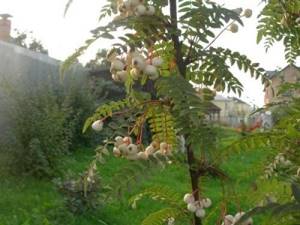
White rowan is unpretentious, but loves sunlight and fertile soil
Selection and preparation of planting material
Two-year-old white rowan seedlings are best suited for planting. When choosing planting material, you should pay attention to the following points:
- the root system of the plant should be healthy and not look weathered and dried out;
- good developed roots have at least 2-3 large branches more than 20 cm long;
- The bark of a healthy plant is not wrinkled, but smooth, without cracks or damaged areas.
Before planting, the white rowan seedling is carefully inspected, broken and damaged shoots and roots are removed. If the plant is planted in the fall, then carefully remove the leaves from the branches, while trying not to damage the buds located in the leaf axils.
Landing algorithm
First of all, you should prepare a planting hole for white rowan:
- it is dug in the shape of a square with a side of 60-80 cm, and the depth is approximately the same;
- fill the pit 1/3 with a mixture of peat compost, humus and topsoil, to which 200 g of superphosphate, a handful of ash and 2-3 shovels of rotted manure are added;
- fill the top with ordinary soil up to half the volume;
- pour a bucket of water into the hole and let it soak completely.
Next, the plant is planted:
- a white rowan seedling is removed from the container (if the roots are open, they are dipped in a mash of clay and water);
- install it in the center of the hole and carefully fill the remaining space with soil;
- compact the soil well in the tree trunk circle;
- watering white rowan;
- mulch the soil at the roots with peat, sawdust, hay, and straw in a layer of 5-7 cm.
Important! White rowan should be planted at a distance of 4-6 m from each other and from other large trees.
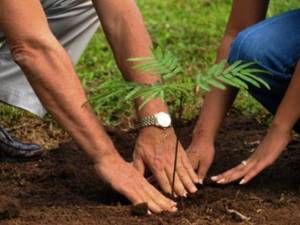
Proper planting of white rowan is the key to the health of the tree
Rowan varieties for Siberia
The best varieties for the harsh climate of Siberia include:
- Moravian rowan;
- Bead;
- Burku;
- Nevezhinskaya;
- Dessert;
- Scarlet large;
- Pomegranate rowan;
- Titanium;
- Sorbinka.
Nevezhenskaya mountain ash adapts best to winter conditions; for trees of all other varieties, it is especially important to create optimal conditions for a comfortable existence. To avoid winter death, experts recommend grafting sweet-fruited varieties onto the crown of Nevezhinskaya.
Rowan flowers easily tolerate temperature drops down to -3 °C. However, it is worth considering that this variety reacts negatively to shading. Gardeners also claim that after frost, the taste of the fruit becomes much better and richer.
It is best to purchase rowan seedlings from nurseries. It is important to ensure that they are free from any mechanical damage, since in the future this can lead to problems with the development of plants, and even to their death.
